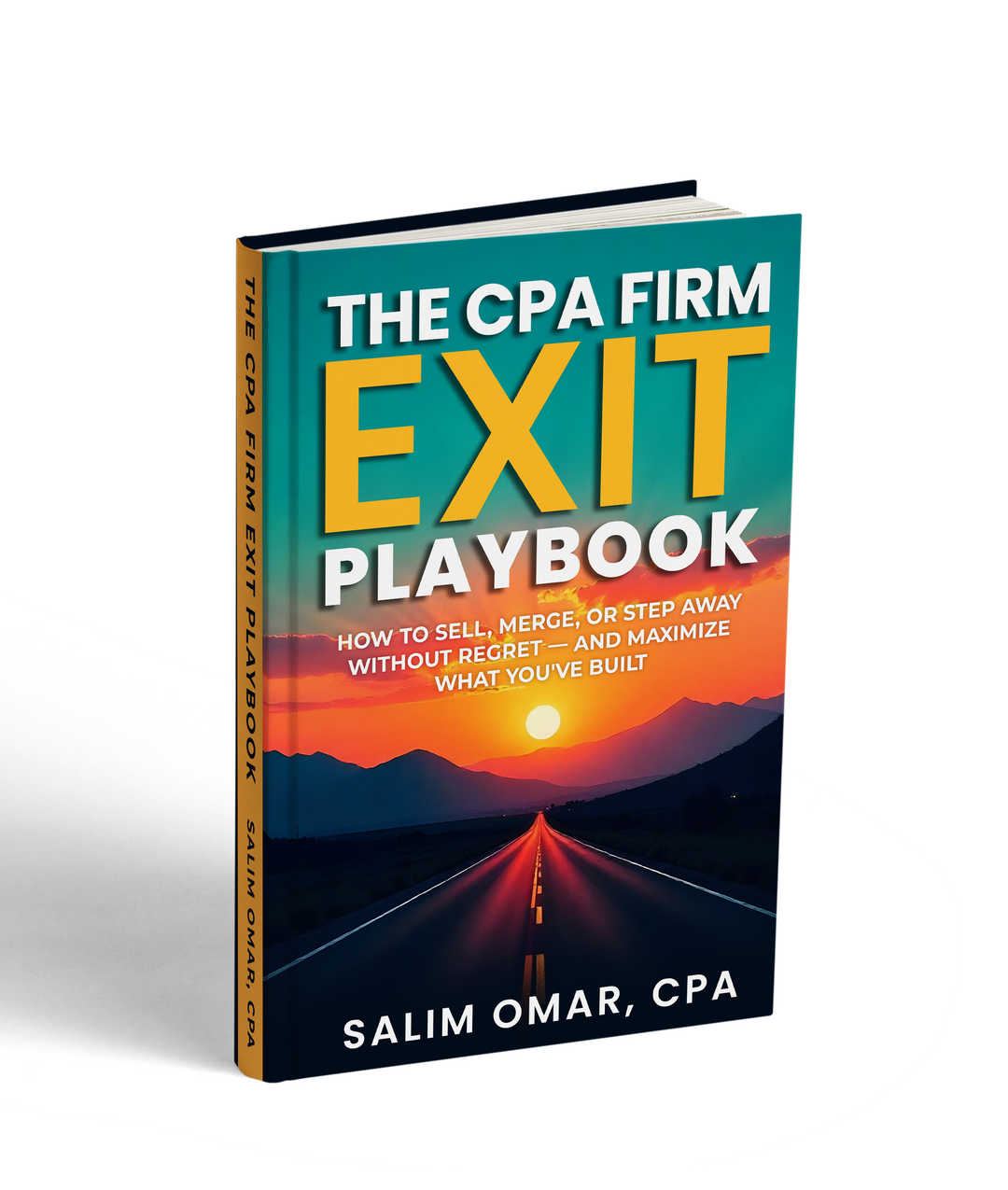Straight Talk for CPA Firm Owners Planning Their Next Chapter
Timely advice, proven strategies, and real-world insights — from one firm owner to another.

I’ve seen two kinds of firms. Firm A: The owner takes Fridays off. Client calls get answered, returns go out on schedule, and the team solves problems without panic. Firm B: The owner checks email on weekends, jumps into every review, and feels the stress build each busy season. Both owners are talented. But one built a system, and the other built a dependency. The Shift from Heroics to Systems Freedom doesn’t come from hitting $1 million in revenue. It comes from structure — repeatable excellence that doesn’t rely on you. Here’s what that looks like behind the scenes: 1. Clear promises. Every service has timelines defined and tracked. No ambiguity. 2. Strong intake. Work doesn’t begin until required documents are received and confirmed. 3. Visible flow. Smaller batches of work move continuously through clear stages. 4. Standardized excellence. Templates for deliverables, checklists for reviews, and agendas for client calls. 5. Capacity planning. Team members pull work when ready, ensuring quality over speed. 6. Proactive communication. Clients never have to chase updates — your team reaches out first. When this structure is in place, the owner’s role shifts from firefighter to conductor. A Simple Example One of my clients — a firm in Texas — used to juggle 80 open projects at once. Deadlines were tracked in spreadsheets, and email chains stretched for miles. We implemented a simple workflow board and weekly review rhythm. Within 60 days, turnaround times improved by 40%, client questions dropped by half, and the owner could finally leave for a week without worrying. That’s not luck. It’s design. How to Get Started You don’t need to fix everything at once. Start with one process — maybe client onboarding or tax return intake. Write down every step. Define who owns it. Set target timelines. Create a shared tracker. Then, meet weekly to see where things bottleneck. Small wins add up fast — and every improvement makes your firm less dependent on you. The Payoff When buyers look at a firm like this, they see stability. They see systems that scale, not an owner holding everything together. That’s what commands higher multiples — and gives you real freedom long before you ever sell. If you’re ready to turn chaos into clockwork, join me for the Exit Readiness Workshop™ — How to Double Your Firm’s Valuation and Exit on Your Terms. Save your seat → www.straighttalktransitions.com/exit-readiness-workshop

Most CPA practitioners know the rule of thumb: your firm might sell for about 0.75× to 1.1× revenue , depending on terms. But here’s a question that rarely gets asked — how does that compare to other professional service firms? Because if you look outside accounting — to consulting, IT services, marketing agencies, or law firms — you’ll notice something surprising: many of them sell for significantly higher multiples. Let’s look at the data, and more importantly, what it means for the future of your firm.

At 10:00 a.m., I placed an Amazon order. By 5:00 p.m., the books were on my doorstep. Last week, I went in for bloodwork at 8:00 a.m. and was done by 8:10 a.m. Two ordinary experiences—but both left me saying, “Wow.” Not because they were dramatic, but because they were flawless . Fast. Predictable. Friction-free. That’s the bar modern consumers live with every day — and your clients are no exception. Now imagine if your CPA firm operated the same way: tax returns, financials, client meetings, and communications all delivered smoothly and on time, every time. That’s not science fiction. It’s what I call operational excellence —and it’s quickly becoming the defining edge of great firms. What Clients Really Want In a recent leadership meeting, I reminded my team that what clients want from us is simple — and universal. They want results , and they want a great experience . 1. Results: Lower my taxes. Make me more profitable. Get my financials in order. 2. Experience: Communicate on time. Make it easy — and even enjoyable — to work with your firm. When both come together, trust deepens and loyalty follows. Clients don’t stay because you prepared their taxes. They stay because you made their financial lives feel simpler, clearer, and more under control. Excellence Is the New Differentiator For decades, CPA firms tried to differentiate on expertise. Today, clients assume you’re competent. What they notice — and remember — is how you deliver. Excellence isn’t about perfection or speed; it’s about consistency, clarity, and care. When your firm becomes known for being dependable, responsive, and forward-thinking, clients talk — and your value compounds. That’s the shift from “standard” to “wow.” What an Excellent Firm Looks Like Here’s what excellence looks like behind the scenes: Clear promises. Service timelines are defined and delivered. No ambiguity. Strong intake systems. Work doesn’t start until every required document is received and confirmed. Flow, not chaos. Smaller batches of work move continuously through visible stages. Standardized excellence. Templates for deliverables, checklists for reviews, and agendas for client calls. Capacity planning. Team members pull work when they have bandwidth, ensuring quality over speed. Proactive communication. Clients never have to chase updates — you reach out first. It’s not about working harder. It’s about creating an environment where excellence is predictable and repeatable. The ROI of Excellence Here’s the payoff: firms that deliver excellence consistently are worth more — often twice as much. Why? Because excellence signals a business that can run without the owner. Predictable results and happy clients mean less key-person risk, steadier cash flow, and higher buyer confidence. But beyond valuation, excellence gives you something harder to measure — and even more valuable: peace of mind. You can take time off, grow your team, and scale your impact knowing your clients are served at a world-class level. Your Next Step If you’re ready to bring Amazon-level excellence to your firm — where client results and experience align perfectly — join me for my upcoming live session: The Exit Readiness Workshop™ How to Double Your Firm’s Valuation — and Exit on Your Terms Because in the next era of our profession, going from standard to “wow” isn’t about doing more. It’s about doing what matters — beautifully, consistently, and on time.

Next week, my wife and I will board a plane for a month-long trip across five countries. We’ll travel from London to India, through Italy, France, and Greece, ending in Jordan before returning home for Thanksgiving. It’s the kind of trip that reminds me how far things have come. Years ago, I couldn’t imagine being away from my CPA firm for more than a few days. Today, Straight Talk CPAs runs smoothly without me — a result of building a team and systems that thrive independently. And whenever I mention these travels, one question always pops up from fellow CPA firm owners: “Salim, what are you reading lately?” So, in the spirit of this trip — reflection, curiosity, and growth — here’s my reading list for the next month, along with what drew me to each book.

Next month, my wife and I will be boarding a plane for our next trip. It will be nearly a month away from home and work. It’ll be our third international trip in the last three years, something I never imagined back when I was buried in the day-to-day grind of running a CPA firm. This trip will take us across five countries. We’ll start in London for my cousin’s daughter’s wedding, a chance to reconnect with family and celebrate life. Then we’ll head to Bhuj, India. It’s the place where my ancestors lived before migrating to Kenya in the late 1800s. It’s a deeply personal stop for me, a chance to walk the same streets they did generations ago. From there, we’ll board an 11-day Mediterranean cruise through Italy, France, and Greece, a bucket-list experience we’ve talked about for years. And finally, we’ll end in Jordan to visit an old college friend and explore the ancient city of Petra before returning home just in time for Thanksgiving. Here’s the remarkable part: I’ll be gone for nearly a month… and my firm will run smoothly without me. Building a Firm That Doesn’t Rely on You That freedom didn’t happen by accident. Years ago, I made a conscious decision to design my firm, Straight Talk CPAs to run without me at the center of everything. That meant: Building a team that could operate independently Focusing on recurring, profitable client work (not one-off engagements) Creating systems and technology that made everything flow seamlessly And most importantly — learning to let go and trust my team to take ownership The result? A firm that not only runs well when I’m away, but one that’s worth far more because it’s not dependent on me. Why It Matters for You Here’s the truth: Firms that aren’t owner-dependent, have strong recurring revenue, and serve profitable clients through efficient systems can command valuations up to twice the industry norm. Think of it this way: A traditional firm generating $1M in revenue might sell for around 1x revenue — about $1M. But that same firm with a solid team, recurring revenue base, and minimal owner dependency could easily command 1.8x or even 2x. That’s the difference between walking away with $1M or $2M and peace of mind knowing your clients and team are taken care of. Freedom and Valuation Go Hand in Hand The ability to travel freely without worrying about emails, deadlines, or client fires isn’t just a lifestyle benefit. It’s proof that your firm is structured for long-term value. That’s exactly what I’ll be teaching in my upcoming live session: The Exit Readiness Workshopᵀᴹ: How to Double Your Firm’s Valuation — and Exit on Your Terms Because ultimately, freedom and value come from the same source — a business that’s built to thrive without you at the center. If you’ve ever wondered how to create a firm that runs without you — and earns more because of it — you’ll want to join us. Link to register for The Exit Readiness Workshopᵀᴹ

When I transitioned Straight Talk CPAs to a virtual model years ago, I’ll admit I was nervous. Would clients adapt? Would my team buy in? Would we lose the personal touch? But making the leap turned out to be one of the best moves I ever made — for my stress levels, my clients, and ultimately the value of my firm. Today, as more firms consider going virtual, I want to lay out the real pros and cons so you can make the decision with eyes wide open. The Pros of Going Virtual 1. Higher Valuation Buyers love portable, systematized firms. A physical-office practice might sell for around 1.0x revenues , while a well-run virtual firm could command 1.4x–1.5x . Example: A $750,000 firm at 1.0x = $750,000. The same firm, if virtual, at 1.4x = $1,050,000 . That’s a $300,000 difference in the owner’s pocket. 2. Larger Talent Pool Virtual firms can hire beyond their zip code, which means access to top talent who want flexibility. One owner I worked with hired a senior tax manager in another state — someone he’d never have reached in a traditional setup. 3. Efficiency + Scalability Cloud-based systems, automation, and virtual workflows reduce manual work and allow firms to scale without adding overhead. 4. Client Convenience Clients increasingly expect digital portals, remote meetings, and faster turnaround. A virtual model not only meets those expectations, but it can also exceed them. The Cons of Going Virtual 1. Culture + Connection Challenges It takes extra effort to keep a remote team engaged. Without the watercooler moments, communication and morale require intentionality. 2. Client Resistance Not every client is ready to give up in-person meetings. Some long-time clients may prefer “old school” relationships, and you could risk losing a few. 3. Technology Investment + Training Going virtual requires upfront costs: cloud systems, security, and training staff. And if people aren’t tech-comfortable, adoption can lag. 4. Blurred Boundaries For some owners and staff, working from home can make it harder to “turn off” — creating new kinds of stress if not managed well. Final Thought Going virtual isn’t just about technology — it’s about building a firm that’s leaner, more valuable, and aligned with the future of the profession. But it’s not for everyone. The question is: do the pros outweigh the cons for you ?

Towards the beginning of the year, I was speaking with a firm owner who had just gone through the sale of his practice. On paper, it looked like a win. He got a fair valuation, the buyer was established, and the deal closed smoothly. But when I asked him how he felt six months later, his answer surprised me. He told me the money was fine, but the transition had left him feeling restless. His staff had scattered, his clients were adjusting to new systems, and he hadn’t really thought about what his own days would look like after stepping away. What he expected to feel like “freedom” actually felt like a loss of identity. That’s the risk of selling too fast. The Rush to Exit It’s easy to see why so many owners want to move quickly once they decide to exit. Brokers dangle big promises. The workload feels heavier than ever. Technology, staffing, and client demands pile up, and selling starts to look like the perfect way out. The problem? Speed often comes at the cost of clarity. Owners who rush the process may: Accept a lower valuation than their firm deserves. Overlook whether the buyer’s culture matches their clients’ needs. Fail to consider how their own purpose and daily life will shift after the sale. The Power of Slowing Down On the flip side, I’ve also seen what happens when a firm owner takes the time to prepare properly. One CPA I talked to was initially leaning toward a quick sale. But instead of jumping at the first offer, he spent time getting clear on what he wanted his next chapter to look like. He realized he didn’t want to completely leave the profession; he just wanted freedom from the parts of ownership that drained him. We mapped out a plan: he merged with another firm that had strong systems in place, stayed involved in client advisory work, and transitioned his role gradually. Not only did he secure a better financial outcome, but a year later he was energized, fulfilled, and still deeply connected to his clients. Why Patience Pays Off The biggest mistake I see isn’t waiting too long to sell — it’s selling before you’re truly ready. Taking time to prepare your practice and clarify your own goals pays off in three ways: Financially: A stronger, more systematized practice commands a higher valuation. Relationally: Clients and staff are more likely to stay when transitions are thoughtfully planned. Personally: You step into the next phase of life with confidence and purpose — not regret. The Takeaway Selling or merging your firm isn’t just a business transaction. It’s a once-in-a-lifetime decision that shapes your finances, your relationships, and your identity. So before you rush, ask yourself: “Am I clear on what I want life to look like after the sale?” Because when you have that clarity, patience stops feeling like delay. It starts feeling like wisdom.

I’ll never forget a conversation I had with a firm owner a few years ago. He had spent decades building his CPA practice. Long hours, loyal clients, a small but dedicated staff. On paper, it looked like a success story. But when he came to me, he looked exhausted. “I know I need to sell,” he said. “But I have no idea what comes after.” That’s when I realized something important: timing isn’t the only factor in an exit. Clarity is. The Trap of “When” Instead of “What’s Next?” Many firm owners spend years circling the same question: When should I sell? It feels logical — get the timing right, and everything falls into place. But the truth is, I’ve seen owners exit after the “perfect timing”… and still regret it. Why? Because they never took the time to ask: What will my life look like six months after I sell? Do I want a clean break, or do I still want to stay involved? How will I replace the sense of purpose my practice gives me? Without clarity, timing alone can’t protect you from disappointment. The Firm Owner Who Found Peace of Mind One practitioner I talked to had initially planned to sell fast — a “get it done” approach. But instead of rushing, we slowed things down. He mapped out what he wanted his next chapter to look like: more family time, less admin work, but still keeping his hand in advisory and mentoring. Instead of a straight sale, he merged with another firm. He got a payout, kept a role he loved, and transitioned into retirement at his own pace. His words to me after a year? “I don’t miss ownership at all. But I’m glad I still get to do the parts of the work I love. And my clients are happier than ever.” Why This Matters for You Whether you’re 1 year away from exiting or 5, clarity is the foundation of a successful transition. Without clarity: You risk chasing a payout, only to feel empty afterward. With clarity: You create an exit plan that supports your finances, your lifestyle, and your peace of mind. The Question to Ask Yourself Today Instead of asking “When should I sell?” try asking: “What do I want my life to look like after I step away?” If you can answer that honestly, the rest of the pieces — timing, valuation, deal structure — start to fall into place.

When I wrote my last post — The CPA Exit Timeline: How Long It Really Takes — I focused on the numbers. The months (or years) it takes. The practical milestones. The logistics. But timelines aren’t just numbers on a calendar. Behind every exit story, there’s a person. And I want to share one with you. A Story I’ll Never Forget Last September, I sat across from a CPA firm owner who had finally decided: It’s time to exit. He assumed it would be simple. Maybe six months, a quick handoff, and then freedom. But as we dug into his practice, the reality hit hard: The firm was too dependent on him personally. There was no real client transition plan. The team wasn’t aligned or prepared. On paper, he thought his practice was worth one number. In reality, he left 30% of potential value on the table. And worse — the whole process felt rushed. He wasn’t leading the transition. It was leading him. Why So Many CPAs Wait Too Long I wish I could say this was an unusual story. It’s not. Most firm owners don’t start planning until they feel ready — but by then, their options have shrunk. And here’s the truth: Buyers don’t pay for effort. They pay for systems, profits, and potential. Transitions take 12–24 months (sometimes longer). Rushing never works in your favor. If you don’t clarify your vision before the process begins, even a “successful” sale can leave you restless or full of regret. What You Can Do Now If you’ve been running your practice for decades, chances are you’ve poured your life into it. Which means your exit isn’t just a financial decision — it’s a life decision. The earlier you start preparing, the more freedom you’ll create for yourself later. Here are a few practical steps you can take today: Run an honest readiness check. Is your practice too dependent on you? Would it run smoothly without you tomorrow? Diversify your revenue streams. Firms with recurring revenue command higher valuations. Clarify your vision. Ask yourself: What does life look like after my firm? (Travel? Family? Part-time advisory work?) Get help early. Having an advisor, mentor, or framework makes the process far smoother — and far more profitable. Why This Matters Selling or merging your firm is likely a once-in-a-lifetime decision. You don’t get a do-over. And if you start too late, the cost isn’t just financial — it’s emotional. You risk leaving money, freedom, and peace of mind behind. The good news? With the right preparation, you can exit on your terms — confidently, profitably, and without regret. Next Step: If you’re even thinking about what comes next, don’t wait until you feel ready. Start now. I invite you to schedule a call with me to talk about your exit readiness and how to plan a transition that truly works for you.
The Roadmap You Wish You Had 5 Years Ago

The CPA Firm Exit Playbook gives you proven strategies to maximize value, avoid common pitfalls, and transition on your own terms.

